Business Environment: Impact of Policies on UK Businesses
VerifiedAdded on 2020/01/21
|17
|5655
|88
Report
AI Summary
This report provides a comprehensive analysis of the UK business environment, exploring various facets that influence organizational operations and performance. It begins by defining the organizational purposes of businesses, using case studies of University Hospitals Bristol, Thorpe Park, and Primark to illustrate mission, vision, and key objectives. The report then delves into the influence of stakeholders, both internal (shareholders, employees) and external (suppliers, trade unions, customers), on business decisions and strategies. Furthermore, it examines the responsibilities of organizations, including employment, health and safety, and consumer and environmental legislation, along with the strategies employed to meet these responsibilities. The report also discusses different economic systems and their impact on resource allocation, focusing on command, free, and mixed economic systems. It analyzes the effects of fiscal and monetary policies on business organizations, as well as the impact of competition policy and other regulatory mechanisms. Additionally, the report examines the determination of pricing and output decisions through different market structures and the influence of market forces and the business and cultural environment on organizations. Finally, it explores the significance of international trade to UK businesses and the impact of global factors and EU policies on these organizations. The report concludes with a summary of the key findings and their implications for businesses operating in the UK.
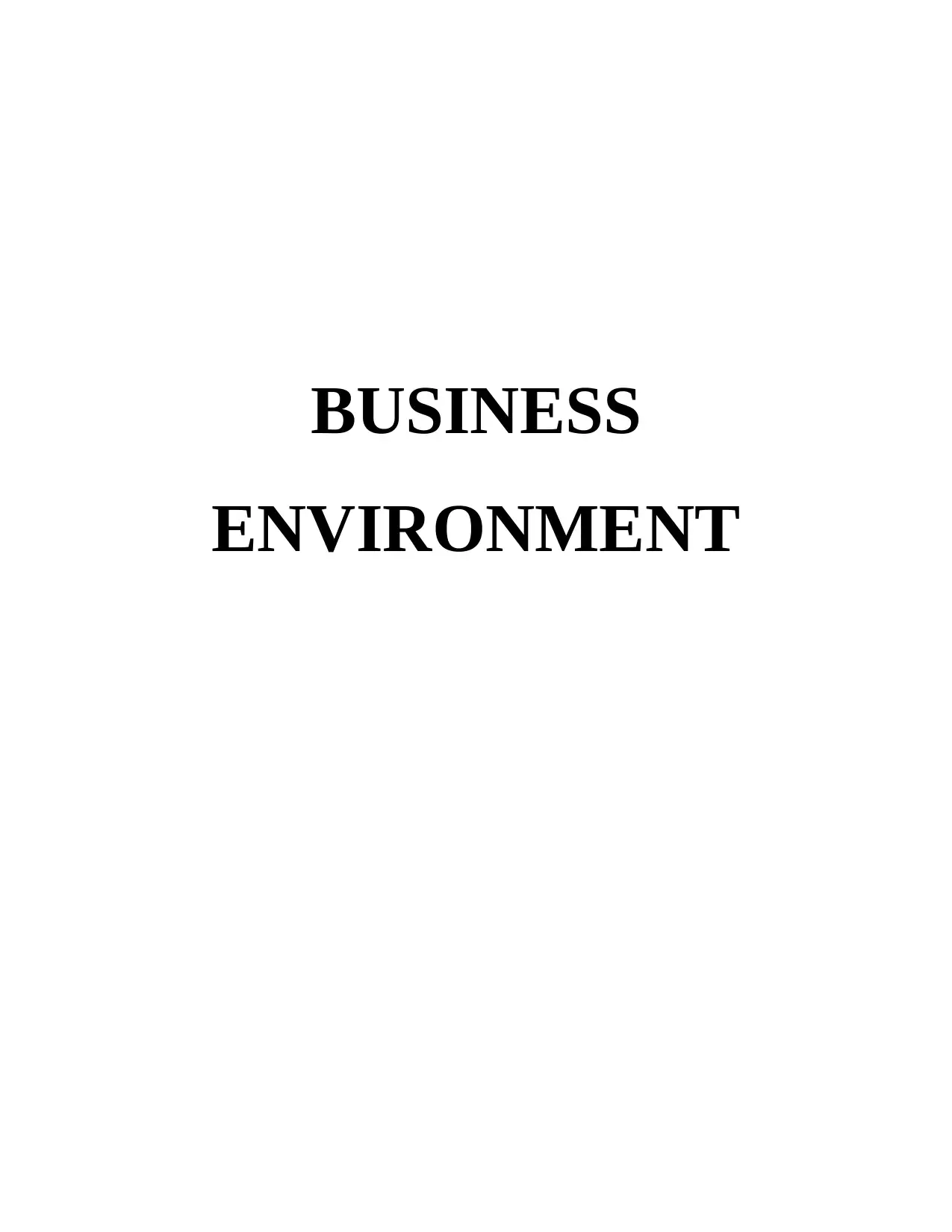
BUSINESS
ENVIRONMENT
ENVIRONMENT
Paraphrase This Document
Need a fresh take? Get an instant paraphrase of this document with our AI Paraphraser
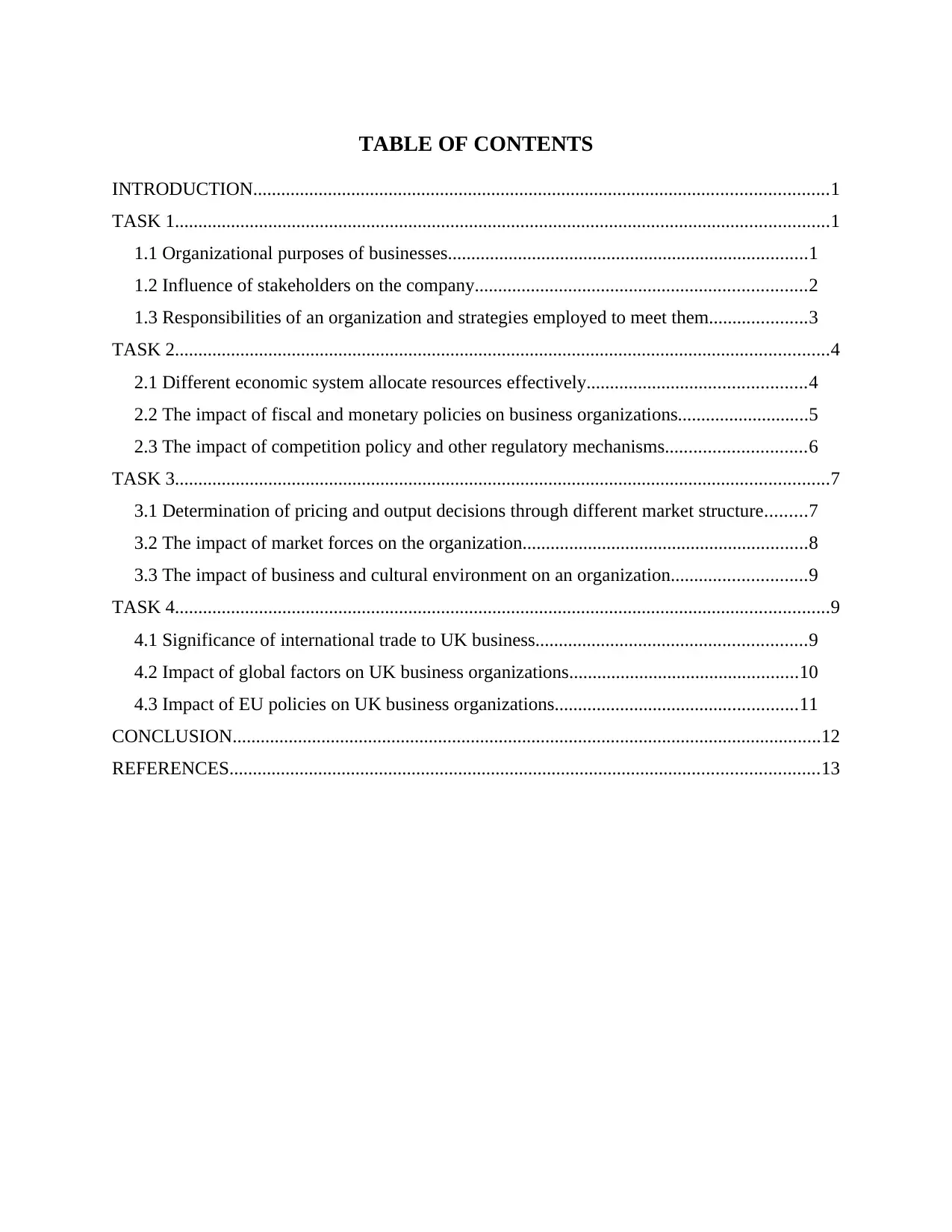
TABLE OF CONTENTS
INTRODUCTION...........................................................................................................................1
TASK 1............................................................................................................................................1
1.1 Organizational purposes of businesses.............................................................................1
1.2 Influence of stakeholders on the company.......................................................................2
1.3 Responsibilities of an organization and strategies employed to meet them.....................3
TASK 2............................................................................................................................................4
2.1 Different economic system allocate resources effectively...............................................4
2.2 The impact of fiscal and monetary policies on business organizations............................5
2.3 The impact of competition policy and other regulatory mechanisms..............................6
TASK 3............................................................................................................................................7
3.1 Determination of pricing and output decisions through different market structure.........7
3.2 The impact of market forces on the organization.............................................................8
3.3 The impact of business and cultural environment on an organization.............................9
TASK 4............................................................................................................................................9
4.1 Significance of international trade to UK business..........................................................9
4.2 Impact of global factors on UK business organizations.................................................10
4.3 Impact of EU policies on UK business organizations....................................................11
CONCLUSION..............................................................................................................................12
REFERENCES..............................................................................................................................13
INTRODUCTION...........................................................................................................................1
TASK 1............................................................................................................................................1
1.1 Organizational purposes of businesses.............................................................................1
1.2 Influence of stakeholders on the company.......................................................................2
1.3 Responsibilities of an organization and strategies employed to meet them.....................3
TASK 2............................................................................................................................................4
2.1 Different economic system allocate resources effectively...............................................4
2.2 The impact of fiscal and monetary policies on business organizations............................5
2.3 The impact of competition policy and other regulatory mechanisms..............................6
TASK 3............................................................................................................................................7
3.1 Determination of pricing and output decisions through different market structure.........7
3.2 The impact of market forces on the organization.............................................................8
3.3 The impact of business and cultural environment on an organization.............................9
TASK 4............................................................................................................................................9
4.1 Significance of international trade to UK business..........................................................9
4.2 Impact of global factors on UK business organizations.................................................10
4.3 Impact of EU policies on UK business organizations....................................................11
CONCLUSION..............................................................................................................................12
REFERENCES..............................................................................................................................13
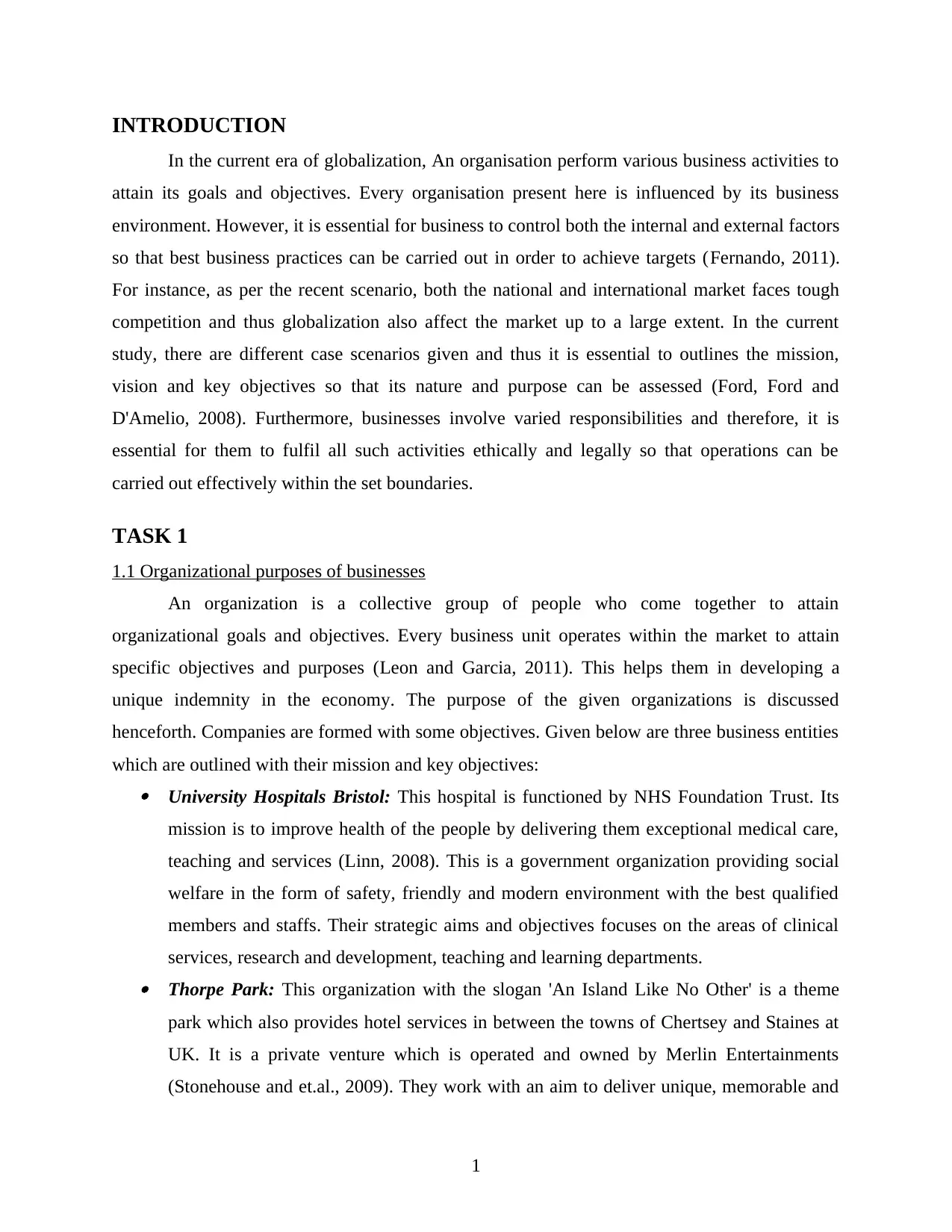
INTRODUCTION
In the current era of globalization, An organisation perform various business activities to
attain its goals and objectives. Every organisation present here is influenced by its business
environment. However, it is essential for business to control both the internal and external factors
so that best business practices can be carried out in order to achieve targets (Fernando, 2011).
For instance, as per the recent scenario, both the national and international market faces tough
competition and thus globalization also affect the market up to a large extent. In the current
study, there are different case scenarios given and thus it is essential to outlines the mission,
vision and key objectives so that its nature and purpose can be assessed (Ford, Ford and
D'Amelio, 2008). Furthermore, businesses involve varied responsibilities and therefore, it is
essential for them to fulfil all such activities ethically and legally so that operations can be
carried out effectively within the set boundaries.
TASK 1
1.1 Organizational purposes of businesses
An organization is a collective group of people who come together to attain
organizational goals and objectives. Every business unit operates within the market to attain
specific objectives and purposes (Leon and Garcia, 2011). This helps them in developing a
unique indemnity in the economy. The purpose of the given organizations is discussed
henceforth. Companies are formed with some objectives. Given below are three business entities
which are outlined with their mission and key objectives: University Hospitals Bristol: This hospital is functioned by NHS Foundation Trust. Its
mission is to improve health of the people by delivering them exceptional medical care,
teaching and services (Linn, 2008). This is a government organization providing social
welfare in the form of safety, friendly and modern environment with the best qualified
members and staffs. Their strategic aims and objectives focuses on the areas of clinical
services, research and development, teaching and learning departments. Thorpe Park: This organization with the slogan 'An Island Like No Other' is a theme
park which also provides hotel services in between the towns of Chertsey and Staines at
UK. It is a private venture which is operated and owned by Merlin Entertainments
(Stonehouse and et.al., 2009). They work with an aim to deliver unique, memorable and
1
In the current era of globalization, An organisation perform various business activities to
attain its goals and objectives. Every organisation present here is influenced by its business
environment. However, it is essential for business to control both the internal and external factors
so that best business practices can be carried out in order to achieve targets (Fernando, 2011).
For instance, as per the recent scenario, both the national and international market faces tough
competition and thus globalization also affect the market up to a large extent. In the current
study, there are different case scenarios given and thus it is essential to outlines the mission,
vision and key objectives so that its nature and purpose can be assessed (Ford, Ford and
D'Amelio, 2008). Furthermore, businesses involve varied responsibilities and therefore, it is
essential for them to fulfil all such activities ethically and legally so that operations can be
carried out effectively within the set boundaries.
TASK 1
1.1 Organizational purposes of businesses
An organization is a collective group of people who come together to attain
organizational goals and objectives. Every business unit operates within the market to attain
specific objectives and purposes (Leon and Garcia, 2011). This helps them in developing a
unique indemnity in the economy. The purpose of the given organizations is discussed
henceforth. Companies are formed with some objectives. Given below are three business entities
which are outlined with their mission and key objectives: University Hospitals Bristol: This hospital is functioned by NHS Foundation Trust. Its
mission is to improve health of the people by delivering them exceptional medical care,
teaching and services (Linn, 2008). This is a government organization providing social
welfare in the form of safety, friendly and modern environment with the best qualified
members and staffs. Their strategic aims and objectives focuses on the areas of clinical
services, research and development, teaching and learning departments. Thorpe Park: This organization with the slogan 'An Island Like No Other' is a theme
park which also provides hotel services in between the towns of Chertsey and Staines at
UK. It is a private venture which is operated and owned by Merlin Entertainments
(Stonehouse and et.al., 2009). They work with an aim to deliver unique, memorable and
1
⊘ This is a preview!⊘
Do you want full access?
Subscribe today to unlock all pages.

Trusted by 1+ million students worldwide

rewarding services of the theme park to its millions of visitors. As being a private sector
company, it aims for profit maximization and higher returns along with customer-
satisfaction. It adopts strategies which create high growth and returns based on strong
brands and portfolio that balances the impact of external factors.
Primark: This is an Irish retailer of clothing, house ware and cosmetics with number of
stores in UK, Ireland and Spain. Associated British Foods is an international food,
ingredients and retail group is its parent company. The company works with a vision to
provide clothing, cosmetics and house wares to its customers at reasonable and affordable
price. The purpose of Primark, as a public undertaking, is to enhance market share and
focus on continuous growth of shareholders (Ravid, 2009). Their objectives are attained
by providing trendy clothes and accessories to the fashion lovers with good use of fabrics
ultimately producing good returns to the company.
1.2 Influence of stakeholders on the company
Stakeholders are group of persons that have a direct interest or concern in an
organization. Primark's internal and external stakeholders, along with their expectations and need
form the company and are discussed below:
Internal stakeholders: The individual or groups who are committed to the company as
shareholders, board members, employees, workers and volunteers are called as internal
stakeholders. Meeting the needs and expectation of internal stakeholders of Primark are
prescribed below: Shareholders: They own shares of the company and influence key decisions and polices.
Shareholders expect from Primark to foster ethical business relationships with all
stakeholders of the company (Record. 2009). To attain this expectation, the company
organises periodical meetings and conferences to communicate their policies and
strategies to the shareholders clearly.
Employees: Employees are the major strength for the company. The employees of
Primark share a common concern in terms of monetary benefits, job security and a
healthy environment to work in. Primark supports the employees by taking their feedback
and providing performance appraisals for their efforts. Moreover, employment laws are
also enforced at this firm (Erkuş-Öztürk, 2009).
2
company, it aims for profit maximization and higher returns along with customer-
satisfaction. It adopts strategies which create high growth and returns based on strong
brands and portfolio that balances the impact of external factors.
Primark: This is an Irish retailer of clothing, house ware and cosmetics with number of
stores in UK, Ireland and Spain. Associated British Foods is an international food,
ingredients and retail group is its parent company. The company works with a vision to
provide clothing, cosmetics and house wares to its customers at reasonable and affordable
price. The purpose of Primark, as a public undertaking, is to enhance market share and
focus on continuous growth of shareholders (Ravid, 2009). Their objectives are attained
by providing trendy clothes and accessories to the fashion lovers with good use of fabrics
ultimately producing good returns to the company.
1.2 Influence of stakeholders on the company
Stakeholders are group of persons that have a direct interest or concern in an
organization. Primark's internal and external stakeholders, along with their expectations and need
form the company and are discussed below:
Internal stakeholders: The individual or groups who are committed to the company as
shareholders, board members, employees, workers and volunteers are called as internal
stakeholders. Meeting the needs and expectation of internal stakeholders of Primark are
prescribed below: Shareholders: They own shares of the company and influence key decisions and polices.
Shareholders expect from Primark to foster ethical business relationships with all
stakeholders of the company (Record. 2009). To attain this expectation, the company
organises periodical meetings and conferences to communicate their policies and
strategies to the shareholders clearly.
Employees: Employees are the major strength for the company. The employees of
Primark share a common concern in terms of monetary benefits, job security and a
healthy environment to work in. Primark supports the employees by taking their feedback
and providing performance appraisals for their efforts. Moreover, employment laws are
also enforced at this firm (Erkuş-Öztürk, 2009).
2
Paraphrase This Document
Need a fresh take? Get an instant paraphrase of this document with our AI Paraphraser
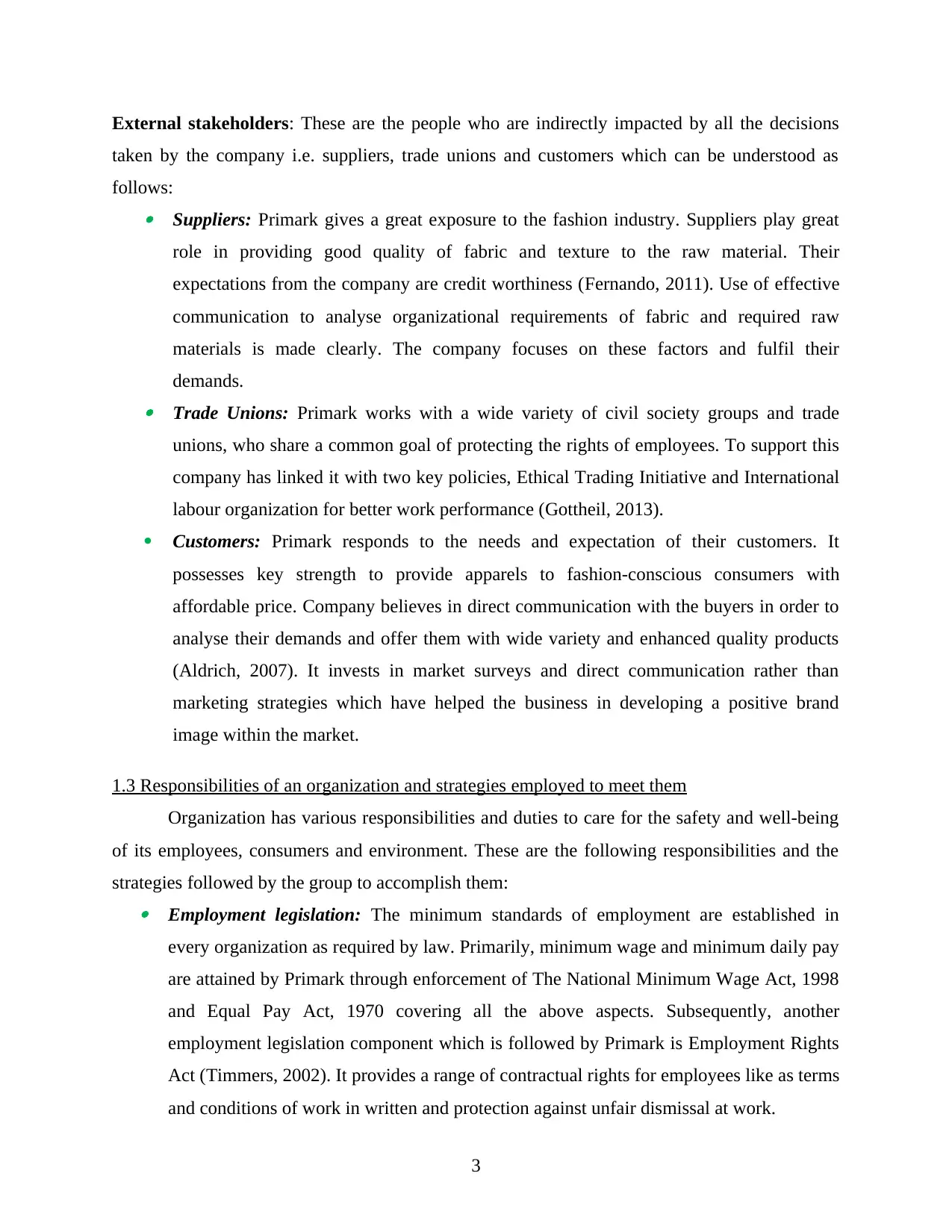
External stakeholders: These are the people who are indirectly impacted by all the decisions
taken by the company i.e. suppliers, trade unions and customers which can be understood as
follows: Suppliers: Primark gives a great exposure to the fashion industry. Suppliers play great
role in providing good quality of fabric and texture to the raw material. Their
expectations from the company are credit worthiness (Fernando, 2011). Use of effective
communication to analyse organizational requirements of fabric and required raw
materials is made clearly. The company focuses on these factors and fulfil their
demands. Trade Unions: Primark works with a wide variety of civil society groups and trade
unions, who share a common goal of protecting the rights of employees. To support this
company has linked it with two key policies, Ethical Trading Initiative and International
labour organization for better work performance (Gottheil, 2013).
Customers: Primark responds to the needs and expectation of their customers. It
possesses key strength to provide apparels to fashion-conscious consumers with
affordable price. Company believes in direct communication with the buyers in order to
analyse their demands and offer them with wide variety and enhanced quality products
(Aldrich, 2007). It invests in market surveys and direct communication rather than
marketing strategies which have helped the business in developing a positive brand
image within the market.
1.3 Responsibilities of an organization and strategies employed to meet them
Organization has various responsibilities and duties to care for the safety and well-being
of its employees, consumers and environment. These are the following responsibilities and the
strategies followed by the group to accomplish them: Employment legislation: The minimum standards of employment are established in
every organization as required by law. Primarily, minimum wage and minimum daily pay
are attained by Primark through enforcement of The National Minimum Wage Act, 1998
and Equal Pay Act, 1970 covering all the above aspects. Subsequently, another
employment legislation component which is followed by Primark is Employment Rights
Act (Timmers, 2002). It provides a range of contractual rights for employees like as terms
and conditions of work in written and protection against unfair dismissal at work.
3
taken by the company i.e. suppliers, trade unions and customers which can be understood as
follows: Suppliers: Primark gives a great exposure to the fashion industry. Suppliers play great
role in providing good quality of fabric and texture to the raw material. Their
expectations from the company are credit worthiness (Fernando, 2011). Use of effective
communication to analyse organizational requirements of fabric and required raw
materials is made clearly. The company focuses on these factors and fulfil their
demands. Trade Unions: Primark works with a wide variety of civil society groups and trade
unions, who share a common goal of protecting the rights of employees. To support this
company has linked it with two key policies, Ethical Trading Initiative and International
labour organization for better work performance (Gottheil, 2013).
Customers: Primark responds to the needs and expectation of their customers. It
possesses key strength to provide apparels to fashion-conscious consumers with
affordable price. Company believes in direct communication with the buyers in order to
analyse their demands and offer them with wide variety and enhanced quality products
(Aldrich, 2007). It invests in market surveys and direct communication rather than
marketing strategies which have helped the business in developing a positive brand
image within the market.
1.3 Responsibilities of an organization and strategies employed to meet them
Organization has various responsibilities and duties to care for the safety and well-being
of its employees, consumers and environment. These are the following responsibilities and the
strategies followed by the group to accomplish them: Employment legislation: The minimum standards of employment are established in
every organization as required by law. Primarily, minimum wage and minimum daily pay
are attained by Primark through enforcement of The National Minimum Wage Act, 1998
and Equal Pay Act, 1970 covering all the above aspects. Subsequently, another
employment legislation component which is followed by Primark is Employment Rights
Act (Timmers, 2002). It provides a range of contractual rights for employees like as terms
and conditions of work in written and protection against unfair dismissal at work.
3
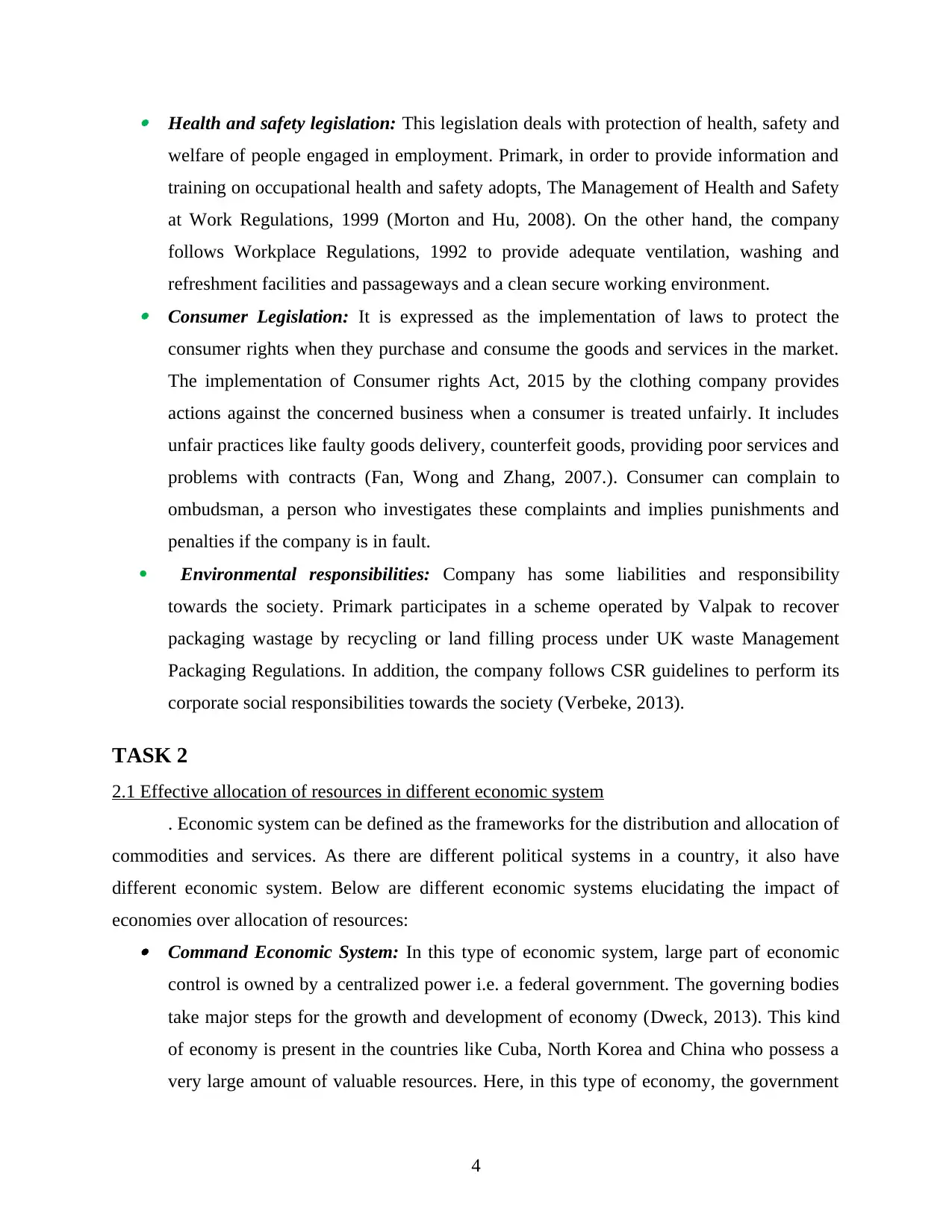
Health and safety legislation: This legislation deals with protection of health, safety and
welfare of people engaged in employment. Primark, in order to provide information and
training on occupational health and safety adopts, The Management of Health and Safety
at Work Regulations, 1999 (Morton and Hu, 2008). On the other hand, the company
follows Workplace Regulations, 1992 to provide adequate ventilation, washing and
refreshment facilities and passageways and a clean secure working environment. Consumer Legislation: It is expressed as the implementation of laws to protect the
consumer rights when they purchase and consume the goods and services in the market.
The implementation of Consumer rights Act, 2015 by the clothing company provides
actions against the concerned business when a consumer is treated unfairly. It includes
unfair practices like faulty goods delivery, counterfeit goods, providing poor services and
problems with contracts (Fan, Wong and Zhang, 2007.). Consumer can complain to
ombudsman, a person who investigates these complaints and implies punishments and
penalties if the company is in fault.
Environmental responsibilities: Company has some liabilities and responsibility
towards the society. Primark participates in a scheme operated by Valpak to recover
packaging wastage by recycling or land filling process under UK waste Management
Packaging Regulations. In addition, the company follows CSR guidelines to perform its
corporate social responsibilities towards the society (Verbeke, 2013).
TASK 2
2.1 Effective allocation of resources in different economic system
. Economic system can be defined as the frameworks for the distribution and allocation of
commodities and services. As there are different political systems in a country, it also have
different economic system. Below are different economic systems elucidating the impact of
economies over allocation of resources: Command Economic System: In this type of economic system, large part of economic
control is owned by a centralized power i.e. a federal government. The governing bodies
take major steps for the growth and development of economy (Dweck, 2013). This kind
of economy is present in the countries like Cuba, North Korea and China who possess a
very large amount of valuable resources. Here, in this type of economy, the government
4
welfare of people engaged in employment. Primark, in order to provide information and
training on occupational health and safety adopts, The Management of Health and Safety
at Work Regulations, 1999 (Morton and Hu, 2008). On the other hand, the company
follows Workplace Regulations, 1992 to provide adequate ventilation, washing and
refreshment facilities and passageways and a clean secure working environment. Consumer Legislation: It is expressed as the implementation of laws to protect the
consumer rights when they purchase and consume the goods and services in the market.
The implementation of Consumer rights Act, 2015 by the clothing company provides
actions against the concerned business when a consumer is treated unfairly. It includes
unfair practices like faulty goods delivery, counterfeit goods, providing poor services and
problems with contracts (Fan, Wong and Zhang, 2007.). Consumer can complain to
ombudsman, a person who investigates these complaints and implies punishments and
penalties if the company is in fault.
Environmental responsibilities: Company has some liabilities and responsibility
towards the society. Primark participates in a scheme operated by Valpak to recover
packaging wastage by recycling or land filling process under UK waste Management
Packaging Regulations. In addition, the company follows CSR guidelines to perform its
corporate social responsibilities towards the society (Verbeke, 2013).
TASK 2
2.1 Effective allocation of resources in different economic system
. Economic system can be defined as the frameworks for the distribution and allocation of
commodities and services. As there are different political systems in a country, it also have
different economic system. Below are different economic systems elucidating the impact of
economies over allocation of resources: Command Economic System: In this type of economic system, large part of economic
control is owned by a centralized power i.e. a federal government. The governing bodies
take major steps for the growth and development of economy (Dweck, 2013). This kind
of economy is present in the countries like Cuba, North Korea and China who possess a
very large amount of valuable resources. Here, in this type of economy, the government
4
⊘ This is a preview!⊘
Do you want full access?
Subscribe today to unlock all pages.

Trusted by 1+ million students worldwide
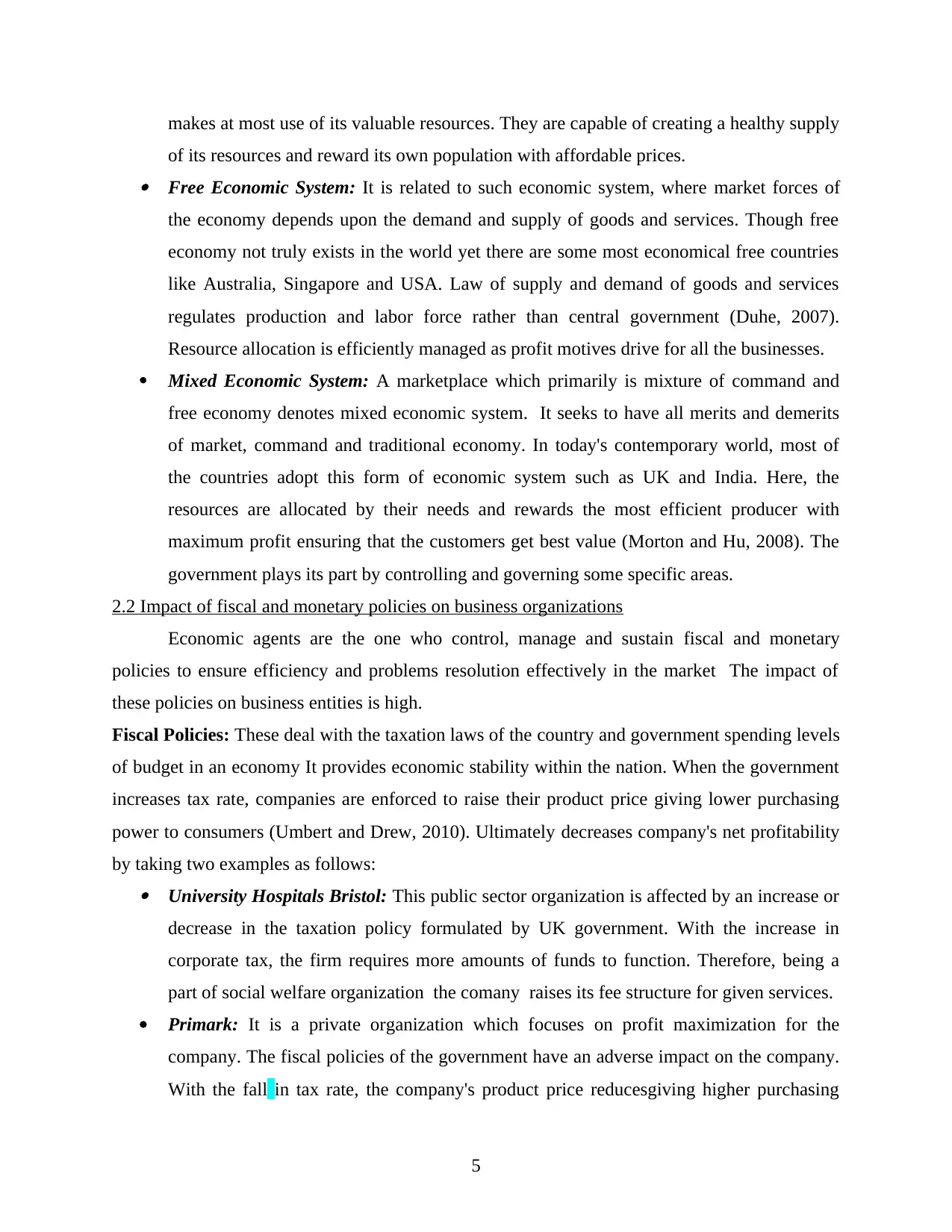
makes at most use of its valuable resources. They are capable of creating a healthy supply
of its resources and reward its own population with affordable prices. Free Economic System: It is related to such economic system, where market forces of
the economy depends upon the demand and supply of goods and services. Though free
economy not truly exists in the world yet there are some most economical free countries
like Australia, Singapore and USA. Law of supply and demand of goods and services
regulates production and labor force rather than central government (Duhe, 2007).
Resource allocation is efficiently managed as profit motives drive for all the businesses.
Mixed Economic System: A marketplace which primarily is mixture of command and
free economy denotes mixed economic system. It seeks to have all merits and demerits
of market, command and traditional economy. In today's contemporary world, most of
the countries adopt this form of economic system such as UK and India. Here, the
resources are allocated by their needs and rewards the most efficient producer with
maximum profit ensuring that the customers get best value (Morton and Hu, 2008). The
government plays its part by controlling and governing some specific areas.
2.2 Impact of fiscal and monetary policies on business organizations
Economic agents are the one who control, manage and sustain fiscal and monetary
policies to ensure efficiency and problems resolution effectively in the market The impact of
these policies on business entities is high.
Fiscal Policies: These deal with the taxation laws of the country and government spending levels
of budget in an economy It provides economic stability within the nation. When the government
increases tax rate, companies are enforced to raise their product price giving lower purchasing
power to consumers (Umbert and Drew, 2010). Ultimately decreases company's net profitability
by taking two examples as follows: University Hospitals Bristol: This public sector organization is affected by an increase or
decrease in the taxation policy formulated by UK government. With the increase in
corporate tax, the firm requires more amounts of funds to function. Therefore, being a
part of social welfare organization the comany raises its fee structure for given services.
Primark: It is a private organization which focuses on profit maximization for the
company. The fiscal policies of the government have an adverse impact on the company.
With the fall in tax rate, the company's product price reducesgiving higher purchasing
5
of its resources and reward its own population with affordable prices. Free Economic System: It is related to such economic system, where market forces of
the economy depends upon the demand and supply of goods and services. Though free
economy not truly exists in the world yet there are some most economical free countries
like Australia, Singapore and USA. Law of supply and demand of goods and services
regulates production and labor force rather than central government (Duhe, 2007).
Resource allocation is efficiently managed as profit motives drive for all the businesses.
Mixed Economic System: A marketplace which primarily is mixture of command and
free economy denotes mixed economic system. It seeks to have all merits and demerits
of market, command and traditional economy. In today's contemporary world, most of
the countries adopt this form of economic system such as UK and India. Here, the
resources are allocated by their needs and rewards the most efficient producer with
maximum profit ensuring that the customers get best value (Morton and Hu, 2008). The
government plays its part by controlling and governing some specific areas.
2.2 Impact of fiscal and monetary policies on business organizations
Economic agents are the one who control, manage and sustain fiscal and monetary
policies to ensure efficiency and problems resolution effectively in the market The impact of
these policies on business entities is high.
Fiscal Policies: These deal with the taxation laws of the country and government spending levels
of budget in an economy It provides economic stability within the nation. When the government
increases tax rate, companies are enforced to raise their product price giving lower purchasing
power to consumers (Umbert and Drew, 2010). Ultimately decreases company's net profitability
by taking two examples as follows: University Hospitals Bristol: This public sector organization is affected by an increase or
decrease in the taxation policy formulated by UK government. With the increase in
corporate tax, the firm requires more amounts of funds to function. Therefore, being a
part of social welfare organization the comany raises its fee structure for given services.
Primark: It is a private organization which focuses on profit maximization for the
company. The fiscal policies of the government have an adverse impact on the company.
With the fall in tax rate, the company's product price reducesgiving higher purchasing
5
Paraphrase This Document
Need a fresh take? Get an instant paraphrase of this document with our AI Paraphraser
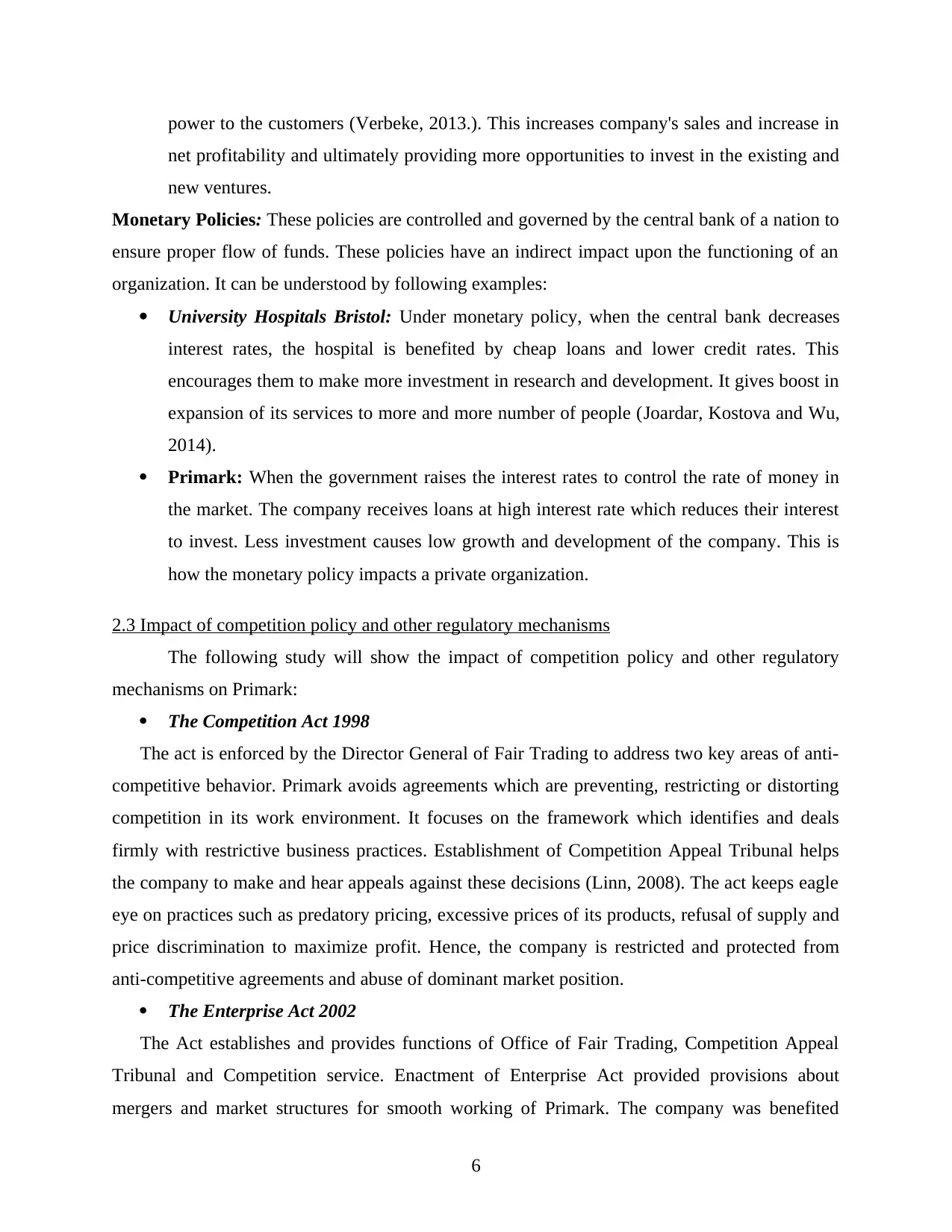
power to the customers (Verbeke, 2013.). This increases company's sales and increase in
net profitability and ultimately providing more opportunities to invest in the existing and
new ventures.
Monetary Policies: These policies are controlled and governed by the central bank of a nation to
ensure proper flow of funds. These policies have an indirect impact upon the functioning of an
organization. It can be understood by following examples:
University Hospitals Bristol: Under monetary policy, when the central bank decreases
interest rates, the hospital is benefited by cheap loans and lower credit rates. This
encourages them to make more investment in research and development. It gives boost in
expansion of its services to more and more number of people (Joardar, Kostova and Wu,
2014).
Primark: When the government raises the interest rates to control the rate of money in
the market. The company receives loans at high interest rate which reduces their interest
to invest. Less investment causes low growth and development of the company. This is
how the monetary policy impacts a private organization.
2.3 Impact of competition policy and other regulatory mechanisms
The following study will show the impact of competition policy and other regulatory
mechanisms on Primark:
The Competition Act 1998
The act is enforced by the Director General of Fair Trading to address two key areas of anti-
competitive behavior. Primark avoids agreements which are preventing, restricting or distorting
competition in its work environment. It focuses on the framework which identifies and deals
firmly with restrictive business practices. Establishment of Competition Appeal Tribunal helps
the company to make and hear appeals against these decisions (Linn, 2008). The act keeps eagle
eye on practices such as predatory pricing, excessive prices of its products, refusal of supply and
price discrimination to maximize profit. Hence, the company is restricted and protected from
anti-competitive agreements and abuse of dominant market position.
The Enterprise Act 2002
The Act establishes and provides functions of Office of Fair Trading, Competition Appeal
Tribunal and Competition service. Enactment of Enterprise Act provided provisions about
mergers and market structures for smooth working of Primark. The company was benefited
6
net profitability and ultimately providing more opportunities to invest in the existing and
new ventures.
Monetary Policies: These policies are controlled and governed by the central bank of a nation to
ensure proper flow of funds. These policies have an indirect impact upon the functioning of an
organization. It can be understood by following examples:
University Hospitals Bristol: Under monetary policy, when the central bank decreases
interest rates, the hospital is benefited by cheap loans and lower credit rates. This
encourages them to make more investment in research and development. It gives boost in
expansion of its services to more and more number of people (Joardar, Kostova and Wu,
2014).
Primark: When the government raises the interest rates to control the rate of money in
the market. The company receives loans at high interest rate which reduces their interest
to invest. Less investment causes low growth and development of the company. This is
how the monetary policy impacts a private organization.
2.3 Impact of competition policy and other regulatory mechanisms
The following study will show the impact of competition policy and other regulatory
mechanisms on Primark:
The Competition Act 1998
The act is enforced by the Director General of Fair Trading to address two key areas of anti-
competitive behavior. Primark avoids agreements which are preventing, restricting or distorting
competition in its work environment. It focuses on the framework which identifies and deals
firmly with restrictive business practices. Establishment of Competition Appeal Tribunal helps
the company to make and hear appeals against these decisions (Linn, 2008). The act keeps eagle
eye on practices such as predatory pricing, excessive prices of its products, refusal of supply and
price discrimination to maximize profit. Hence, the company is restricted and protected from
anti-competitive agreements and abuse of dominant market position.
The Enterprise Act 2002
The Act establishes and provides functions of Office of Fair Trading, Competition Appeal
Tribunal and Competition service. Enactment of Enterprise Act provided provisions about
mergers and market structures for smooth working of Primark. The company was benefited
6

about the disclosure of information obtained under competition and consumer legislation. The
disqualification of directors engaging in certain anti-competitive practices developed positive
image in the minds of its stakeholders (Moschandreas, 2000). Also, the law protected collective
interest of the consumer by keeping an eye on price-fixing and limited supply. Hence,
enforcement of this law reformed competition law, strengthen consumer protection and
modernized the insolvency regime.
TASK 3
3.1 Determining pricing and output decisions through different market structure
Market structures are the combination of several elements of binding buyers, sellers and
products together. Price and output determination are the key consequences of different
paradigm. So, the different market structures determining their pricing and output policies can be
understood below:
Perfect Competition: In the perfect competition, buyers and sellers are numerous in
quantity and are well-informed about absence of elements of monopoly. There are many
firms providing homogeneous products. The buyers and sellers are free to enter and
leave the market. Also, the sellers and buyers seek to maximize their profit (Carroll and
Buchholtz, 2014).
The market price and output is determined by the equilibrium between demand and supply
in a market period. If the price is very high like rice and pulses, the seller will be prepared to sell
the whole stock. But during the low price period, they will hold back the most of stock for better
time when the price will rise again. In this type of market structure, black marketing is performed
quiet often:
Oligopoly Market: In this type of market,there few firms to produce goods and services
and good amount of buyers. Here, the competition is not perfect yet there are many
rivalries that are present to build strong agonistic conditions. New entry of firms is quiet
difficult (Day and Schoemaker, 2006.). There are many examples of oligopoly market
like automobile industry, airline industry, pharmaceuticals and mass media.
The price and output is determined by small number of competing firms. Each firm
controls an important proportion of the total supply. Here, when any firm takes an action its
7
disqualification of directors engaging in certain anti-competitive practices developed positive
image in the minds of its stakeholders (Moschandreas, 2000). Also, the law protected collective
interest of the consumer by keeping an eye on price-fixing and limited supply. Hence,
enforcement of this law reformed competition law, strengthen consumer protection and
modernized the insolvency regime.
TASK 3
3.1 Determining pricing and output decisions through different market structure
Market structures are the combination of several elements of binding buyers, sellers and
products together. Price and output determination are the key consequences of different
paradigm. So, the different market structures determining their pricing and output policies can be
understood below:
Perfect Competition: In the perfect competition, buyers and sellers are numerous in
quantity and are well-informed about absence of elements of monopoly. There are many
firms providing homogeneous products. The buyers and sellers are free to enter and
leave the market. Also, the sellers and buyers seek to maximize their profit (Carroll and
Buchholtz, 2014).
The market price and output is determined by the equilibrium between demand and supply
in a market period. If the price is very high like rice and pulses, the seller will be prepared to sell
the whole stock. But during the low price period, they will hold back the most of stock for better
time when the price will rise again. In this type of market structure, black marketing is performed
quiet often:
Oligopoly Market: In this type of market,there few firms to produce goods and services
and good amount of buyers. Here, the competition is not perfect yet there are many
rivalries that are present to build strong agonistic conditions. New entry of firms is quiet
difficult (Day and Schoemaker, 2006.). There are many examples of oligopoly market
like automobile industry, airline industry, pharmaceuticals and mass media.
The price and output is determined by small number of competing firms. Each firm
controls an important proportion of the total supply. Here, when any firm takes an action its
7
⊘ This is a preview!⊘
Do you want full access?
Subscribe today to unlock all pages.

Trusted by 1+ million students worldwide
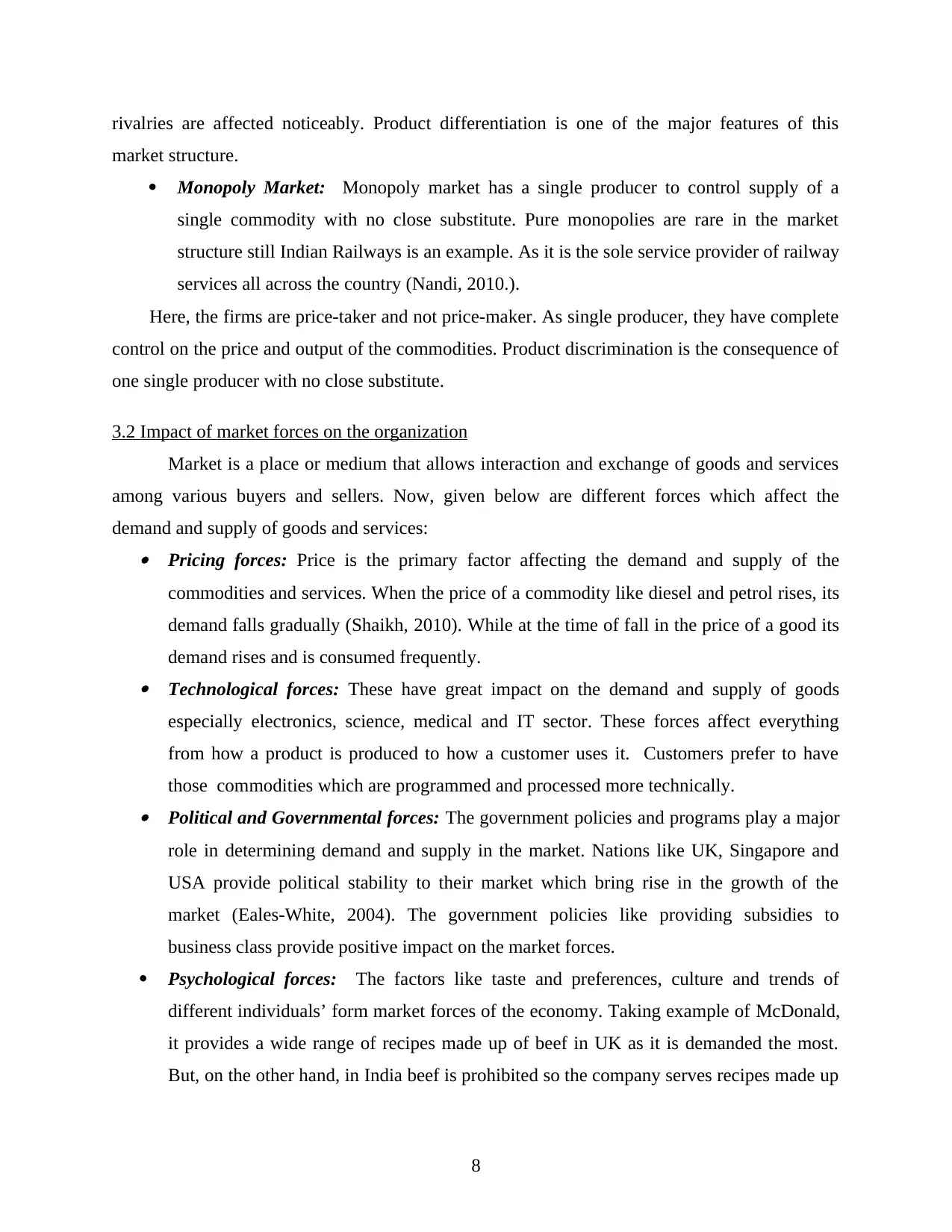
rivalries are affected noticeably. Product differentiation is one of the major features of this
market structure.
Monopoly Market: Monopoly market has a single producer to control supply of a
single commodity with no close substitute. Pure monopolies are rare in the market
structure still Indian Railways is an example. As it is the sole service provider of railway
services all across the country (Nandi, 2010.).
Here, the firms are price-taker and not price-maker. As single producer, they have complete
control on the price and output of the commodities. Product discrimination is the consequence of
one single producer with no close substitute.
3.2 Impact of market forces on the organization
Market is a place or medium that allows interaction and exchange of goods and services
among various buyers and sellers. Now, given below are different forces which affect the
demand and supply of goods and services: Pricing forces: Price is the primary factor affecting the demand and supply of the
commodities and services. When the price of a commodity like diesel and petrol rises, its
demand falls gradually (Shaikh, 2010). While at the time of fall in the price of a good its
demand rises and is consumed frequently. Technological forces: These have great impact on the demand and supply of goods
especially electronics, science, medical and IT sector. These forces affect everything
from how a product is produced to how a customer uses it. Customers prefer to have
those commodities which are programmed and processed more technically. Political and Governmental forces: The government policies and programs play a major
role in determining demand and supply in the market. Nations like UK, Singapore and
USA provide political stability to their market which bring rise in the growth of the
market (Eales-White, 2004). The government policies like providing subsidies to
business class provide positive impact on the market forces.
Psychological forces: The factors like taste and preferences, culture and trends of
different individuals’ form market forces of the economy. Taking example of McDonald,
it provides a wide range of recipes made up of beef in UK as it is demanded the most.
But, on the other hand, in India beef is prohibited so the company serves recipes made up
8
market structure.
Monopoly Market: Monopoly market has a single producer to control supply of a
single commodity with no close substitute. Pure monopolies are rare in the market
structure still Indian Railways is an example. As it is the sole service provider of railway
services all across the country (Nandi, 2010.).
Here, the firms are price-taker and not price-maker. As single producer, they have complete
control on the price and output of the commodities. Product discrimination is the consequence of
one single producer with no close substitute.
3.2 Impact of market forces on the organization
Market is a place or medium that allows interaction and exchange of goods and services
among various buyers and sellers. Now, given below are different forces which affect the
demand and supply of goods and services: Pricing forces: Price is the primary factor affecting the demand and supply of the
commodities and services. When the price of a commodity like diesel and petrol rises, its
demand falls gradually (Shaikh, 2010). While at the time of fall in the price of a good its
demand rises and is consumed frequently. Technological forces: These have great impact on the demand and supply of goods
especially electronics, science, medical and IT sector. These forces affect everything
from how a product is produced to how a customer uses it. Customers prefer to have
those commodities which are programmed and processed more technically. Political and Governmental forces: The government policies and programs play a major
role in determining demand and supply in the market. Nations like UK, Singapore and
USA provide political stability to their market which bring rise in the growth of the
market (Eales-White, 2004). The government policies like providing subsidies to
business class provide positive impact on the market forces.
Psychological forces: The factors like taste and preferences, culture and trends of
different individuals’ form market forces of the economy. Taking example of McDonald,
it provides a wide range of recipes made up of beef in UK as it is demanded the most.
But, on the other hand, in India beef is prohibited so the company serves recipes made up
8
Paraphrase This Document
Need a fresh take? Get an instant paraphrase of this document with our AI Paraphraser
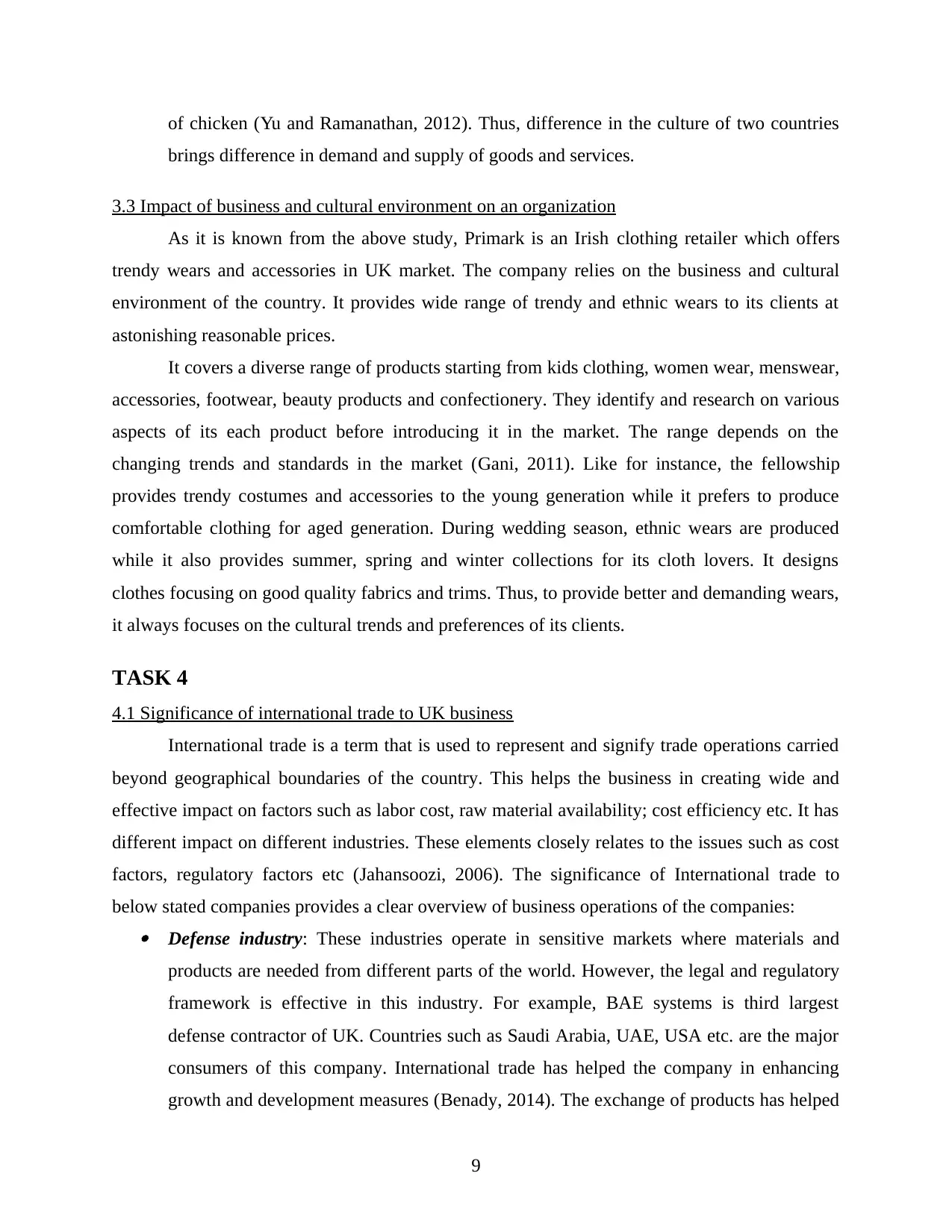
of chicken (Yu and Ramanathan, 2012). Thus, difference in the culture of two countries
brings difference in demand and supply of goods and services.
3.3 Impact of business and cultural environment on an organization
As it is known from the above study, Primark is an Irish clothing retailer which offers
trendy wears and accessories in UK market. The company relies on the business and cultural
environment of the country. It provides wide range of trendy and ethnic wears to its clients at
astonishing reasonable prices.
It covers a diverse range of products starting from kids clothing, women wear, menswear,
accessories, footwear, beauty products and confectionery. They identify and research on various
aspects of its each product before introducing it in the market. The range depends on the
changing trends and standards in the market (Gani, 2011). Like for instance, the fellowship
provides trendy costumes and accessories to the young generation while it prefers to produce
comfortable clothing for aged generation. During wedding season, ethnic wears are produced
while it also provides summer, spring and winter collections for its cloth lovers. It designs
clothes focusing on good quality fabrics and trims. Thus, to provide better and demanding wears,
it always focuses on the cultural trends and preferences of its clients.
TASK 4
4.1 Significance of international trade to UK business
International trade is a term that is used to represent and signify trade operations carried
beyond geographical boundaries of the country. This helps the business in creating wide and
effective impact on factors such as labor cost, raw material availability; cost efficiency etc. It has
different impact on different industries. These elements closely relates to the issues such as cost
factors, regulatory factors etc (Jahansoozi, 2006). The significance of International trade to
below stated companies provides a clear overview of business operations of the companies: Defense industry: These industries operate in sensitive markets where materials and
products are needed from different parts of the world. However, the legal and regulatory
framework is effective in this industry. For example, BAE systems is third largest
defense contractor of UK. Countries such as Saudi Arabia, UAE, USA etc. are the major
consumers of this company. International trade has helped the company in enhancing
growth and development measures (Benady, 2014). The exchange of products has helped
9
brings difference in demand and supply of goods and services.
3.3 Impact of business and cultural environment on an organization
As it is known from the above study, Primark is an Irish clothing retailer which offers
trendy wears and accessories in UK market. The company relies on the business and cultural
environment of the country. It provides wide range of trendy and ethnic wears to its clients at
astonishing reasonable prices.
It covers a diverse range of products starting from kids clothing, women wear, menswear,
accessories, footwear, beauty products and confectionery. They identify and research on various
aspects of its each product before introducing it in the market. The range depends on the
changing trends and standards in the market (Gani, 2011). Like for instance, the fellowship
provides trendy costumes and accessories to the young generation while it prefers to produce
comfortable clothing for aged generation. During wedding season, ethnic wears are produced
while it also provides summer, spring and winter collections for its cloth lovers. It designs
clothes focusing on good quality fabrics and trims. Thus, to provide better and demanding wears,
it always focuses on the cultural trends and preferences of its clients.
TASK 4
4.1 Significance of international trade to UK business
International trade is a term that is used to represent and signify trade operations carried
beyond geographical boundaries of the country. This helps the business in creating wide and
effective impact on factors such as labor cost, raw material availability; cost efficiency etc. It has
different impact on different industries. These elements closely relates to the issues such as cost
factors, regulatory factors etc (Jahansoozi, 2006). The significance of International trade to
below stated companies provides a clear overview of business operations of the companies: Defense industry: These industries operate in sensitive markets where materials and
products are needed from different parts of the world. However, the legal and regulatory
framework is effective in this industry. For example, BAE systems is third largest
defense contractor of UK. Countries such as Saudi Arabia, UAE, USA etc. are the major
consumers of this company. International trade has helped the company in enhancing
growth and development measures (Benady, 2014). The exchange of products has helped
9
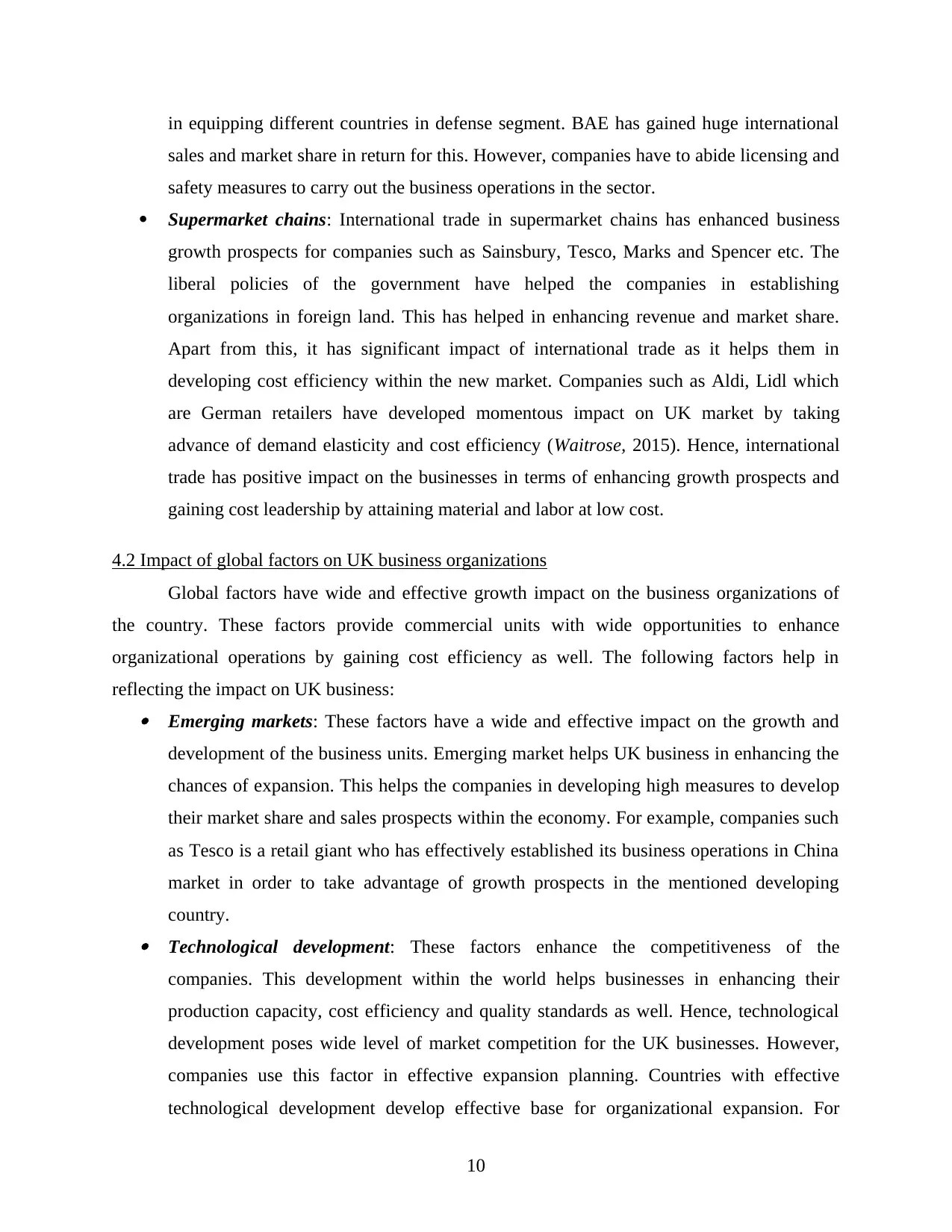
in equipping different countries in defense segment. BAE has gained huge international
sales and market share in return for this. However, companies have to abide licensing and
safety measures to carry out the business operations in the sector.
Supermarket chains: International trade in supermarket chains has enhanced business
growth prospects for companies such as Sainsbury, Tesco, Marks and Spencer etc. The
liberal policies of the government have helped the companies in establishing
organizations in foreign land. This has helped in enhancing revenue and market share.
Apart from this, it has significant impact of international trade as it helps them in
developing cost efficiency within the new market. Companies such as Aldi, Lidl which
are German retailers have developed momentous impact on UK market by taking
advance of demand elasticity and cost efficiency (Waitrose, 2015). Hence, international
trade has positive impact on the businesses in terms of enhancing growth prospects and
gaining cost leadership by attaining material and labor at low cost.
4.2 Impact of global factors on UK business organizations
Global factors have wide and effective growth impact on the business organizations of
the country. These factors provide commercial units with wide opportunities to enhance
organizational operations by gaining cost efficiency as well. The following factors help in
reflecting the impact on UK business: Emerging markets: These factors have a wide and effective impact on the growth and
development of the business units. Emerging market helps UK business in enhancing the
chances of expansion. This helps the companies in developing high measures to develop
their market share and sales prospects within the economy. For example, companies such
as Tesco is a retail giant who has effectively established its business operations in China
market in order to take advantage of growth prospects in the mentioned developing
country. Technological development: These factors enhance the competitiveness of the
companies. This development within the world helps businesses in enhancing their
production capacity, cost efficiency and quality standards as well. Hence, technological
development poses wide level of market competition for the UK businesses. However,
companies use this factor in effective expansion planning. Countries with effective
technological development develop effective base for organizational expansion. For
10
sales and market share in return for this. However, companies have to abide licensing and
safety measures to carry out the business operations in the sector.
Supermarket chains: International trade in supermarket chains has enhanced business
growth prospects for companies such as Sainsbury, Tesco, Marks and Spencer etc. The
liberal policies of the government have helped the companies in establishing
organizations in foreign land. This has helped in enhancing revenue and market share.
Apart from this, it has significant impact of international trade as it helps them in
developing cost efficiency within the new market. Companies such as Aldi, Lidl which
are German retailers have developed momentous impact on UK market by taking
advance of demand elasticity and cost efficiency (Waitrose, 2015). Hence, international
trade has positive impact on the businesses in terms of enhancing growth prospects and
gaining cost leadership by attaining material and labor at low cost.
4.2 Impact of global factors on UK business organizations
Global factors have wide and effective growth impact on the business organizations of
the country. These factors provide commercial units with wide opportunities to enhance
organizational operations by gaining cost efficiency as well. The following factors help in
reflecting the impact on UK business: Emerging markets: These factors have a wide and effective impact on the growth and
development of the business units. Emerging market helps UK business in enhancing the
chances of expansion. This helps the companies in developing high measures to develop
their market share and sales prospects within the economy. For example, companies such
as Tesco is a retail giant who has effectively established its business operations in China
market in order to take advantage of growth prospects in the mentioned developing
country. Technological development: These factors enhance the competitiveness of the
companies. This development within the world helps businesses in enhancing their
production capacity, cost efficiency and quality standards as well. Hence, technological
development poses wide level of market competition for the UK businesses. However,
companies use this factor in effective expansion planning. Countries with effective
technological development develop effective base for organizational expansion. For
10
⊘ This is a preview!⊘
Do you want full access?
Subscribe today to unlock all pages.

Trusted by 1+ million students worldwide
1 out of 17
Related Documents
Your All-in-One AI-Powered Toolkit for Academic Success.
+13062052269
info@desklib.com
Available 24*7 on WhatsApp / Email
![[object Object]](/_next/static/media/star-bottom.7253800d.svg)
Unlock your academic potential
Copyright © 2020–2025 A2Z Services. All Rights Reserved. Developed and managed by ZUCOL.





